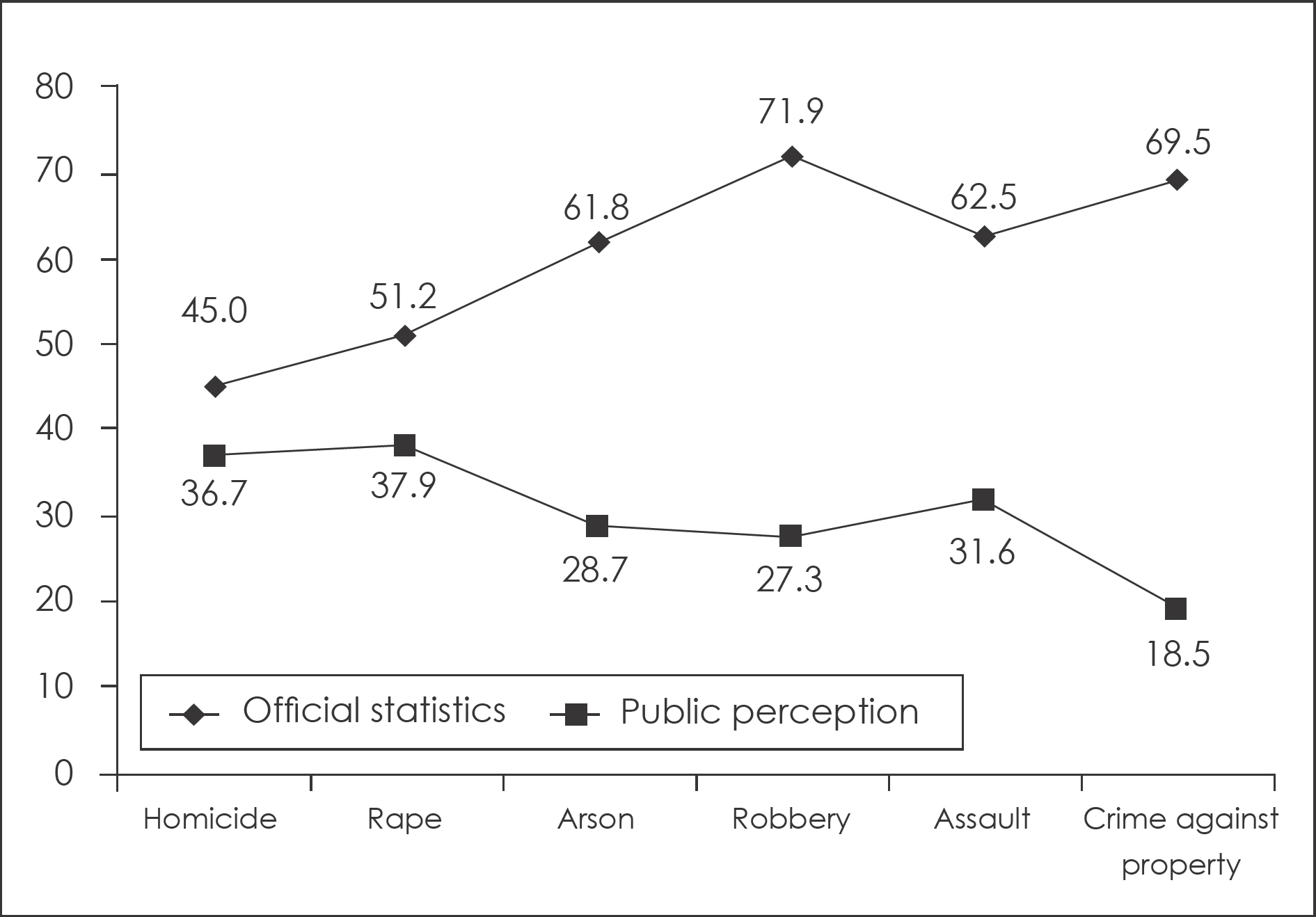Korean J Schizophr Res.
2016 Apr;19(1):25-31. 10.16946/kjsr.2016.19.1.25.
A Comparative Analysis of the Official Crime Statistics of People with Mental Illness and Public Perception
- Affiliations
-
- 1Department of Social Psychology, Sookmyung Women's University, Seoul, Korea. jsirispark@hotmail.com
- KMID: 2344027
- DOI: http://doi.org/10.16946/kjsr.2016.19.1.25
Abstract
OBJECTIVES
There exists only a limited number of studies on the people's perception of criminality of people with mental illness. People's fear of the dangerousness of people with mental illness may have been exaggerated, and yet there are few studies exploring whether people's view of the crime rates of mentally ill people are correct or not.
METHODS
A total of 363 college students participated in the present study. The present study first compared the official statistics of the crime rates of the mentally ill with the public perception. In addition, the rates of mentally ill offenders with previous convictions across crime types are compared with people's perception.
RESULTS
Compared to the official crime statistics, people's estimates of crime rates of mentally ill offenders were grossly exaggerated across crime types, including fraud, assault, rape, robbery, theft, homicide, and arson. Furthermore, the rates of mentally ill offenders with previous convictions across all crime types on the official crime statistics were actually higher than people's estimates.
CONCLUSION
The present findings reveal that people's view of the crime rates of mentally ill people is considerably distorted. There is an urgent need to clarify these prejudices in order to help people with mentally illness adjust to society and to prevent them from committing crime.
Keyword
MeSH Terms
Figure
Reference
-
1). Park C, Kim SW, Lee JY, Na HJ, Lee GY, Park JH, et al. Attitude toward Psychiatric Medication among College Students Majoring in Nursing Science and Social Welfare. Korean J Schizophr Res. 2014; 17:86–92.
Article2). Chang DW. A study on the relationship between mental illness and crimes. Seoul: Korean Institute of Criminology;1990.3). Park JS. A Attitude toward the Dangerousness of the mentally ill. Korean J Schizophr Res. 2015; 18:16–20.4). Corrigan PW, Penn DL. Lessons from social psychology from dis-crediting psychiatric stigma. Am Psychologist. 1999; 54:765–776.5). Shrivastava A, Johnston ME, Thakar M, Shrivastava S, Sarkhel G, Sunita I. Origin and impact of stigma and discrimination in schizophrenia-patients' perception: Mumbai study. Stigma Res Action. 2011; 1:67–72.
Article6). Hinshaw S, Cicchetti D. Stigma and mental disorder: Conceptions of illness, public attitudes, personal disclosure and social policy. Development and Psychopathology. 2000; 12:555–598.7). Park SJ. Misperception and Bias in Personal Evaluations on Crime Trends. Korean Criminological Rev. 2012; 23:233–265.8). Seo DW. Prevention of crimes committed by mentally ill patients and strategies for their treatment and rehabilitation. Health-Wel-fare Police Forum. 2003; 8:77–87.9). Hwang SD. A Study on the relationship between mental illness and crime. Korean J Soc Welfare. 1993; 21:221–242.10). Lee BH. A study on the custom of media reports on the police investigation: from 2004 to 2008. Korean Academy of Public Safety and Criminal Justice. 2010; 39:169–194.11). Lee BG, Lee GW. A study on the effects of crime reports by mass media upon public perception of crime. Seoul: Korean Institute of Criminology;1995.12). Thornton JA, Wahl OF. Impact of a newspaper article on attitudes toward mental illness. J Community Psychol. 1996; 24:17–24.
Article13). National Police Agency. Police Statistical Yearbook 2013. Seoul: National Police Agency;2014.14). Martin JK, Pescosolido BA, Tuch SA. Of fear and loathing: The role of disturbing behavior labels, and causal attribution in shaping public attitudes toward people with mental illness. J Health Soc Behav. 2000; 41:208–223.15). Link BG. Understanding labeling effects in the area of mental disorders: An assessment of the effects of expectations of rejection. Am Socio Rev. 1987; 52:96–112.
Article16). Ryu SA. Attitudes toward the employability of people with mental disorders: Comparative study of Korea and the U.S. J Soc Personality Psychol. 2009; 23:1–25.17). Supreme Prosecutor's Office. 2014 Analytic reports on crimes. Seoul: Supreme Prosecutor's Office;2014.18). Steadman H, Vanderwyst D, Ribner S. Comparing arrest rates of mental patients and criminal offenders. Am J Psychiatry. 1978; 135:1218–1220.19). Couture SM, Penn DL. Interpersonal contact and the stigma of mental illness: A review of the literature. J Ment Health. 2003; 12:291–305.
Article20). Phelan JC, Link BG. Fear of people with mental illnesses: The role of personal and impersonal contact and exposure to threat or harm. J Health Soc Behav. 2004; 45:68–80.
Article
- Full Text Links
- Actions
-
Cited
- CITED
-
- Close
- Share
- Similar articles
-
- Public Attention to Crime of Schizophrenia and Its Correlation with Use of Mental Health Services in Patients with Schizophrenia
- Attitudes Toward the Dangerousness of the Mentally Ill
- Mistaken Belief about Mental Illness
- A Study of Criminal Manifestation and Characteristics of Elderly Mental Illness
- The Attitudes of Community Leaders Toward Mental Illness



